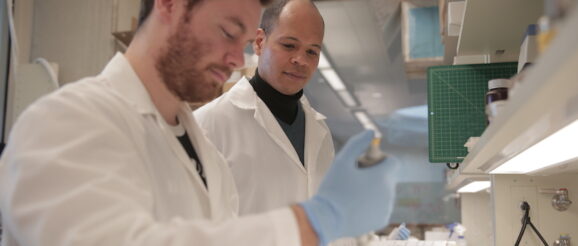Neural tissue engineering work earns Ashton WARF Innovation Award – College of Engineering – University of Wisconsin-Madison

Postdoctoral research associate Gavin Knight (left) and Associate Professor Randolph Ashton conduct research in Ashton’s lab. This photo was taken before the COVID-19 pandemic impacted campus operations.
Randolph Ashton, an associate professor of biomedical engineering, and three members of his lab have taken top honors in the 2020 Wisconsin Alumni Research Foundation (WARF) Innovation Award contest.
Ashton’s team was one of two winners announced Dec. 8, 2020, chosen from more than 400 invention disclosures submitted to WARF by University of Wisconsin-Madison researchers over the past 12 months. Each winning team receives $10,000 in the annual contest.
Ashton, postdoctoral research associates Nisha Iyer and Gavin Knight and recent graduate Benjamin Knudsen earned the honor for their work using stem cells to derive improved brain and spinal cord tissue models, which can better model disease and hone drug testing.
“This will allow us to create models of the human brain and spinal cord that are anatomically similar to what we see in a developing human embryo and really will allow us to push the technology of creating these types of brain and spinal cord models in a dish to the next level, so that they really closely model what normally forms in the human embryo,” says Ashton, who’s also the associate director of the UW-Madison Stem Cell and Regenerative Medicine Center. “That allows us to be much more precise in the therapies we can develop for the diseases that we can now model for these tissues.”
Professor Jenny Gumperz and Associate Scientist Dana Baiu of the Department of Medical Microbiology and Immunology in the School of Medicine and Public Health were the other Innovation Award winners.
Two other teams from the College of Engineering were among the six finalists for the awards: Megan McClean, an assistant professor of biomedical engineering, and Bhuvana Krishnaswamy, an assistant professor of electrical and computer engineering, for their work bridging synthetic biology and electronic communication to create new biosensors; and Bu Wang, an assistant professor of civil and environmental engineering, and postdoctoral research associate Raghavendra Ragipani for a green process using common industrial wastes to capture carbon dioxide.
Author:
Staff
